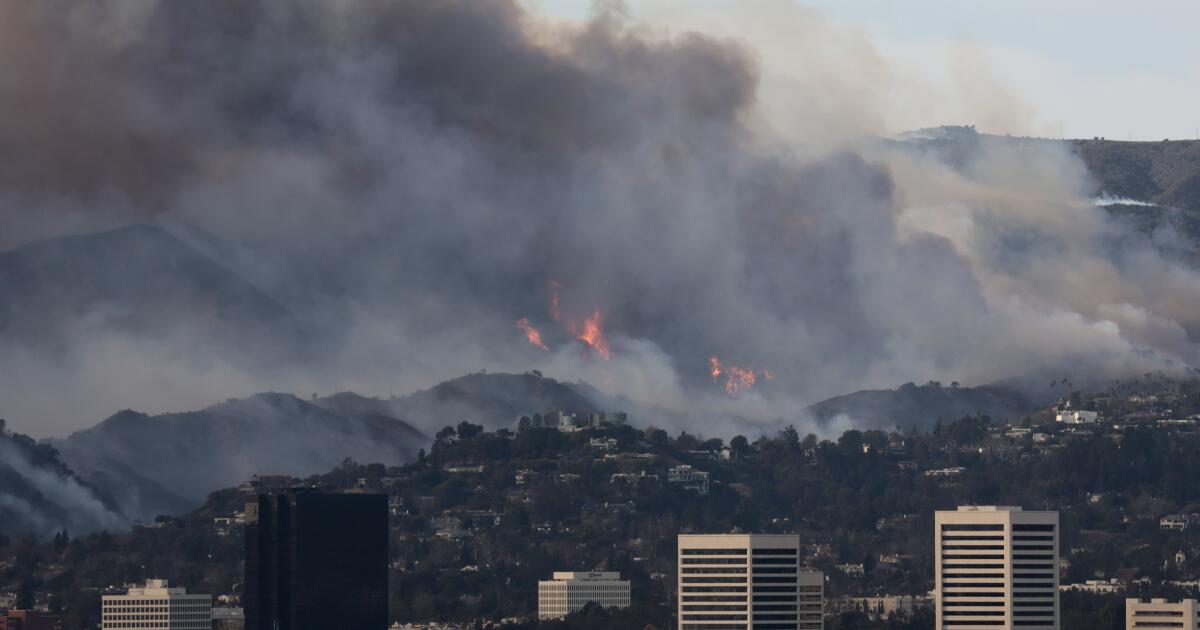As an enormous plume of dark gray smoke rose hundreds of feet from the nearby Palisades fire on Wednesday afternoon, obscuring the sun and turning everything in the north end of Santa Monica an apocalyptic shade of orange, a small army of hired hands went about their business as if it were just another day on the job.
Amid the tension and anxiety in this normally cozy seaside enclave — Santa Monica looks and feels like an extremely prosperous Midwestern suburb plunked on a cliff overlooking the Pacific Ocean — landscapers kept trimming, builders kept building, and delivery trucks steered around electric cars packed with fleeing residents.
The weather was “fine for trimming trees,” said Adrian Rodriguez, as he tossed a coiled garden hose into the back of an ancient Nissan pickup. “The sparks aren’t falling yet.”
It was 3 p.m., and Rodriguez, who lives in Los Angeles but is originally from Querétaro, Mexico, had already put in an eight-hour day as one of the worst natural disasters in California history raged around him.
Most of his labor was a little farther from the fire line, he stressed.
And that’s how it goes this awful week in west Los Angeles, normally a dreamscape of gorgeous beaches and breathtaking sunsets. Those who seem to have everything you could possibly ask for are justifiably terrified of losing it. Those who don’t must keep working to get by.
A couple of blocks closer to the ocean, on Palisades Avenue, David Salais and an entirely Spanish-speaking crew of construction workers reluctantly pulled their tools from a $13-million (according to Zillow) home. They were loading the stuff into their trucks as a Santa Monica Police Department cruiser rolled by, repeating a mandatory evacuation order from the loudspeaker.
“We work wind, rain, fire, natural disaster. We don’t stop. We just keep on going until the cops kick us out,” Salais said, leaning on his 6-foot-long carpenter’s level and nodding in the direction of the police car.
Salais, from Santa Paula, said he was born in the U.S. and is “half Mexican.” He was the only person in the stream of workers sauntering out of the house who was willing to be interviewed in English, mostly.
Mexicans are wired differently, he joked, gesturing to the guys around him. “Tienen ganas pa trabajar — they really want to work!”
A few blocks south, as residents struggled to shuttle precious keepsakes from their elegant homes — financial documents, irreplaceable family photos, an enormous stand-up double bass — to cars waiting in the street, Marvin Altamirano steered his UPS delivery truck between them.
With a sun visor on backward and a pen stuck in the elastic band, he patiently removed one of his earbuds to better hear a reporter ask why he was still making deliveries.
“We gotta pay bills,” he said. “It’s not like they’re gonna pay us to stop working and leave.”
He had been making deliveries in Pacific Palisades on Tuesday, during the worst of the fire, but hadn’t gotten too close, he said. The smell of smoke was worse in Santa Monica at 3 p.m. Wednesday, he said.
Would he make a delivery if the street were on fire?
“Depends,” he said, with a laugh. “Like, how close is it, really? If it was down the street, yeah, I’d drop it and go.”
Just before the evacuation order reached their worksite, on Marguerita Avenue near Ocean Avenue, a construction crew calmly repaired a damaged balcony at an apartment building, the team’s ladder lashed to the structure to help brace it in the howling wind.
“We have to survive; that’s why we’re still here,” said Josue Curiel, who lives in Inglewood and is originally from Jalisco, Mexico. Everyone on his crew of about half a dozen were also born south of the border.
“If you’re a worker, you’re hungry, so that’s what it is.”

